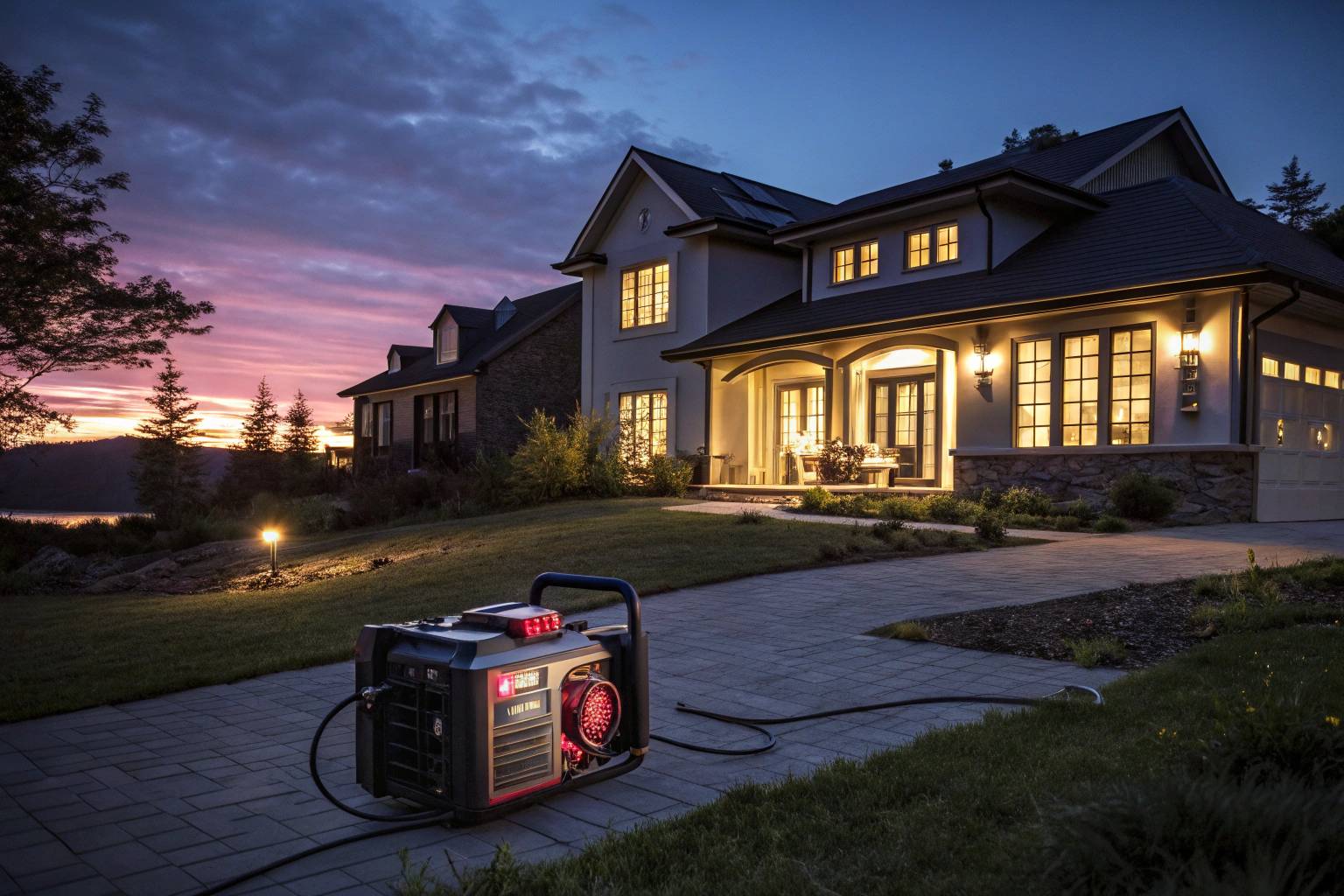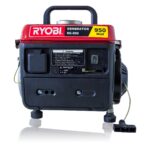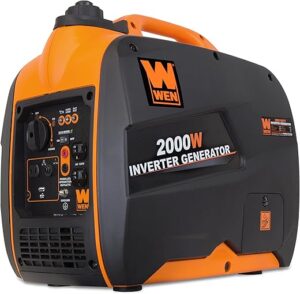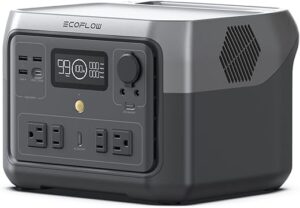Selecting the right portable generator size is essential to guarantee uninterrupted backup power for your home during outages while avoiding unnecessary upfront and fuel expenses.
An undersized unit can overload and trip circuits when you need power most, whereas an oversized generator drives up budget efficiency concerns by wasting fuel and increasing purchase costs.
In this guide, you’ll learn how to perform manual wattage calculations—tallying running and starting watts of your key appliances—and leverage online generator sizing calculators for a streamlined, accurate assessment of your home’s unique power requirements.
Key Generator Power Metrics
In generator sizing, understanding key power metrics—particularly running vs starting watts, voltage/frequency requirements, and power factor—ensures you choose a unit that reliably meets your home’s energy demands without overspending on excess capacity.
Running watts denote the continuous power a generator can supply to keep appliances operating, while starting watts account for the brief surge needed to kick motor-driven loads like refrigerators and air conditioners into action.
Voltage and frequency compatibility (e.g., 120/240 V at 60 Hz in North America) prevent damage to your electronics and ensure safe, efficient operation.
Finally, considering a generator’s power factor—commonly 0.8 in diesel models—and its efficiency is essential, as it impacts the apparent power capacity (kVA) required to support real power loads (kW).
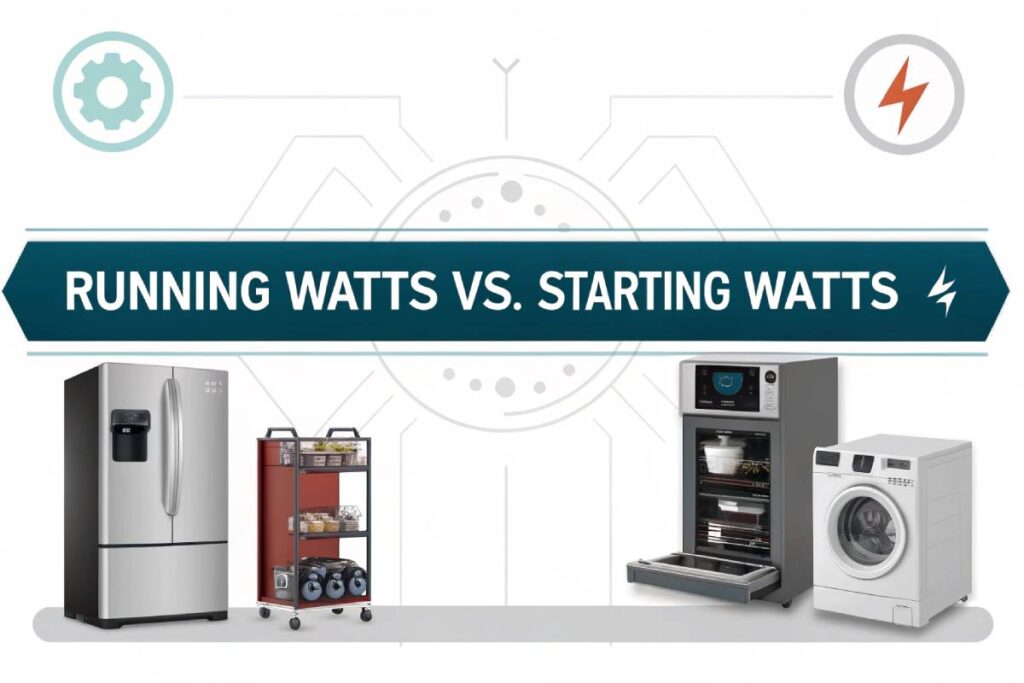
Running vs. Starting Watts
- Running (Rated) Watts: The continuous power output a generator can deliver indefinitely to sustain connected loads without tripping breakers.
- Starting (Surge) Watts: The extra, short-duration power needed to start motor-driven appliances; this surge often ranges from 10–20 % above running watts for the generator itself, but may reach 2–3× the running wattage of specific appliances.
| Metric | Definition | Typical Ratio |
|---|---|---|
| Running Watts | Continuous power rating for steady operation of appliances and equipment | n/a |
| Starting Watts | Momentary surge power to overcome motor inertia when starting inductive loads | 10–20 % above running (generator); 2–3× running (appliances) |
Other Electrical Terms
- Voltage: Portable generators typically feature 120 V outlets for standard circuits and may include 120/240 V outlets (using a split-phase winding) to power high-demand appliances or feed a home transfer switch.
- Frequency: Indicates how many times per second the current alternates; North American generators output 60 Hz to match residential wiring, while many other regions use 50 Hz—mismatches can cause motors and electronics to operate poorly or incur damage.
- Power Factor & Efficiency: Power factor (PF = kW/kVA) measures how effectively real power is used versus apparent capacity; most diesel generators are rated at PF 0.8, meaning a 100 kVA unit can supply only 80 kW of real power—sizing in kVA ensures you accommodate both real and reactive loads without overload.
How to Calculate Your Power Needs
In this section, we’ll break down the precise steps to calculate your home’s power requirements so you can size a portable generator with confidence.
You’ll learn how to compile a comprehensive appliance list with both running and starting watts, perform a clear manual calculation by summing loads and adding the largest surge, and finally build in a 20 % buffer for future needs.
Compile a List of Household Appliances with Wattage Ratings
Begin by listing every appliance you intend to power during an outage. Check manufacturer nameplates or trusted online guides to record each device’s continuous (running) watts and, for motor-driven units, their surge (starting) watts.
Having these figures at your fingertips is the foundation of accurate generator sizing.
| Appliance | Running Watts | Starting Watts |
|---|---|---|
| Refrigerator | 300–800 W | ~1,000–1,200 W |
| Sump Pump (1/3 HP) | 800 W | 1,300–2,900 W |
| Microwave Oven | 600–1,000 W | 600–1,000 W |
| Window Air Conditioner | 1,000–1,800 | 3,000–5,400 W |
| Well Pump (1/2 HP) | 1,000 W | 2,100–4,000 W |
Demonstrate Manual Calculation
- Sum All Running Watts
Add up the “Running Watts” column to get your total continuous load. For example, if you plan to run a refrigerator (550 W avg), sump pump (800 W), microwave (1,000 W), window AC (1,400 W avg), and well pump (1,000 W), your total running watts would be: 550 + 800 + 1,000 + 1,400 + 1,000 = 4,750 W - Add the Largest Surge Wattage
Identify the single appliance with the highest “Starting Watts” (in this case, the window AC at 5,400 W) and add it to your running total. This gives you the total starting wattage needed to fire up motors without tripping the generator: 4,750 W + 5,400 W = 10,150 W
Factor in a Safety Margin
To ensure your generator never runs at maximum capacity—and to accommodate future appliance additions—add a 20 % safety margin to your calculated loads. This buffer not only boosts reliability under peak demand but also extends engine life and reduces overload risk:
10,150 W × 1.20 = 12,180 W
With these three clear steps, you’ll have a precise wattage target—running and starting with margin—that guides you to the ideal portable generator size for your home’s backup power needs.
Room-by-Room Power Requirements
Breaking down your home’s power needs by room helps you size a portable generator precisely and avoid both overloads and excess capacity.
Kitchens combine moderate loads like refrigerators (100–400 W), microwaves (600–1,000 W) and dishwashers (~1,800 W); living rooms draw from TVs (50–200 W), LED lighting (~10 W per bulb) and ceiling fans (75 W); bedrooms often use lighting plus window A/C units (500–1,500 W); bathrooms may include electric water heaters (~4,000 W) and ventilation fans (~50 W); and outdoor workshops handle drills (720 W running, 1,800 W surge), well pumps (500–2,500 W) and electric lawn mowers (1,440 W running, 4,320 W surge).
Kitchen
Your kitchen typically contains some of the highest continuous loads in the home.
| Appliance | Running Watts |
|---|---|
| Refrigerator | 100–400 W |
| Microwave | 600–1,000 W |
| Dishwasher | 1,800 W |
Tip: Always check the rating plate or manual for exact wattages, as models vary.
Living Room
Entertainment and comfort features define living-room loads.
| Appliance | Running Watts |
|---|---|
| TV | 50–200 W |
| LED Lighting (per bulb) | ~10 W |
| Ceiling Fan | 75 W |
| Phone Chargers & Small Electronics | 5–20 W |
Tip: Multiply the number of light bulbs by 10 W for a quick lighting estimate.
Bedrooms
Primary bedroom circuits often include lighting and climate control.
- Lighting: Typically 60–100 W total per bedroom (LED or CFL fixtures).
- Window A/C Units or HVAC Vents: 500–1,500 W running, with surges of up to 3,000–5,400 W on startup.
Tip: If multiple A/C vents share one circuit, add their running watts but only the highest single surge.
Bathroom
Even small spaces can hide significant loads.
| Appliance | Running Watts |
|---|---|
| Electric Water Heater | 4,000 W |
| Ventilation Fan | ~50 W |
Tip: If your water heater is gas-fired, its electrical draw may be as low as 100–200 W for controls and ignition.
Outdoor/Workshop
Tools and pumps often demand high power.
| Appliance | Running Watts | Starting Watts |
|---|---|---|
| Corded Drill | 720 W | 1,800 W |
| Well Pump | 500–2,500 W | n/a |
| Electric Lawn Mower | 1,440 W | 4,320 W |
Tip: Power tools rarely run all at once—sum running watts of those you expect to use simultaneously, then add the single highest surge wattage.
By tallying these room-by-room benchmarks, you can accurately sum your running loads, add the single largest starting surge, and determine the generator capacity that balances reliable backup power with budget efficiency.
Portable Generator Size Calculator Walkthrough
In this walkthrough, you’ll explore several popular online generator sizing tools—Home Depot’s comprehensive Buying Guide, Briggs & Stratton’s Standby and Portable Generator Selectors, Generac’s interactive calculators, Champion’s Portable Generator Selector, Northern Tool’s Wattage Calculator, Lowe’s Wattage Calculator, and Electric Generators Direct’s Home Standby tool—that each prompt you for a tailored list of appliances, home size or usage scenario, fuel type, and more to calculate your exact wattage needs.
You’ll learn how to enter appliance types and quantities step by step, then interpret the resulting running vs. surge wattage recommendations to choose a generator that reliably balances continuous loads with motor-starting surges.
Popular Online Calculators and Their Inputs
| Calculator | Inputs Required |
|---|---|
| Home Depot – Generator Buying Guide | Device list, usage scenario (e.g., whole house vs. essentials), fuel type (gasoline, propane, diesel), budget range |
| Briggs & Stratton – Standby Generator Sizing Tool | Home square footage, fuel selection (NG/LP), essential appliances (lights, furnace fan, fridge, sump pump, etc.), additional appliance checkboxes |
| Generac – Generator Sizing Calculator | EV charging requirement, backup scope (whole home vs. selected circuits), comfort level, optional extras (hot tub, workshop tools) |
| Champion – Portable Generator Selector | Primary use (home, jobsite, recreation), select power needs via categories, downloadable wattage chart for reference |
| Northern Tool – Wattage Calculator | List of tools/appliances and their rated running watts (JS-enabled interface) |
| Lowe’s – Wattage Calculator | Usage scenario (home, RV, worksite), pick specific devices and quantities from drop-downs, auto-calculated total wattage |
| Briggs & Stratton – Portable Generator Sizing Tool | Frequency of use (occasional, seasonal, frequent), select items you’ll power, displays compatible models |
| Electric Generators Direct – Standby Sizing Calculator | Select all devices you want to run simultaneously, enter running wattages, tool outputs recommended generator size |
| Generac – Pro Standby Sizing Tool | Outputs power estimate in kW and BTU for lighting, motors, fixed loads after appliance selection |
| Generac PDF Worksheet | Manual worksheet for recording running wattages side-by-side and summing loads for a quick offline calculation |
Step-by-Step Guide on Using a Calculator
- Launch the Calculator
- Navigate to the brand’s sizing tool (e.g., Home Depot’s Buying Guide, Generac’s Generator Sizing Calculator).
- Define Your Scenario
- Select home size or usage type (whole-house, essentials only, jobsite, RV). Choose fuel type if prompted (natural gas, propane, gasoline).
- Add Your Appliances/Devices
- Click icons or checkboxes for each appliance (e.g., refrigerator, TV, well pump). Specify quantities where applicable (e.g., number of lights, A/C units).
- Review Wattage Breakdown
- The tool tallies running watts for continuous loads and adds the single highest starting-surge wattage to your total. Check the summary to ensure all critical loads are included.
- Generate and Export Results
- Receive a recommended generator size (in watts or kW). Most tools let you print, save, or email the results for later comparison shopping.
How to Interpret the Recommended Generator Wattage
- Recommended Running vs. Surge
Calculators usually display two figures: continuous (running) wattage and surge (starting) wattage. For example, a result of “8,500 W running / 10,200 W surge” indicates the generator can handle 8.5 kW of steady loads plus a 10.2 kW motor-start surge. - Model Matching
Cross‐reference the tool’s wattage recommendation with the manufacturer’s model specs. Choose a generator whose running and surge ratings meet or exceed the calculator’s output. - Rounding Up for Buffer
Always round up to the next standard size (e.g., from 9,000 W to 10,000 W) to maintain a 10–20 % buffer for future appliance additions and to avoid continuous max-load operation. - Consider Fuel Efficiency
Larger generators may run more efficiently at lower loads; verify fuel consumption rates and tank capacities to balance runtime with budget efficiency.
By following this walkthrough—selecting your tool of choice, entering accurate appliance data, and understanding the output—you’ll confidently choose a portable generator that delivers reliable backup power without overspending on excess capacity.
Choosing the Right Generator Model
Selecting the right generator model means balancing fuel type benefits—gasoline’s availability and power density, diesel’s efficiency and durability, propane’s clean burn and long-term storage, and dual-fuel flexibility—then comparing runtime ratings, noise levels, and portability features (for example, the Champion 4500 W model runs 14 h on gas or 21 h on propane at 25 % load with a noise level of 61 dBA and weighs 99.2 lbs).
Finally, align your choice with your budget—generators range from about $200 for compact inverters to $3,000+ for high-capacity or multi-fuel units—and lean on expert ratings from Consumer Reports, Better Homes & Gardens, and Real Simple to select a reliable, long-lasting model.
Compare Fuel Options
| Fuel Type | Pros | Cons |
|---|---|---|
| Gasoline | Affordable and widely available, portable units tend to be more compact and cost less than standby systems. | Fuel degrades over months, requiring stabilizers; less efficient at high loads compared to diesel. |
| Propane | Clean-burning with lower emissions and no fuel degradation in storage; safe long-term fuel stockpiling. | Superior fuel economy and torque; robust engines require less frequent maintenance and stored indefinitely. |
| Diesel | Superior fuel economy and torque; robust engines require less frequent maintenance and store indefinitely. | Higher up-front generator cost, louder operation, and higher particulate emissions; diesel fuel can gel in cold weather without additives. |
| Dual-Fuel | Ultimate flexibility—run on gasoline or propane to match availability; often share identical power ratings in both modes. | Propane mode typically offers ~10–20 % less runtime at the same load; added system complexity may mean higher purchase cost and slightly lower peak power. |
Evaluate Runtime Ratings, Noise Levels, and Portability
| Model | Running W | Runtime @25 % Load | Noise | Weight |
|---|---|---|---|---|
| Champion 4500 W Electric Start Dual Fuel (Model 201228) | 3,500 W gas / 3,150 W propane | 14 h gas / 21 h propane | 61 dBA @ 23 ft | 99.2 lbs |
| Champion 5500 W Dual Fuel Inverter | 4,000 W gas / 3,600 W propane | 20 h gas / 15 h propane | 61 dBA @ 23 ft | (not specified) |
| Champion 6000 W Gasoline Portable Generator | 7,000 W | 6,000 W | 74 dBA @ 23 ft | (not specified) |
| Champion 8500 W Electric Start Inverter | 3,500 W gas / 3 150 W propane | 3,500 W gas / 3,150 W propane | 70 dBA @ half load | (not specified) |
- Runtime Ratings: Inverter models often extend run times by throttling down at light loads, while open-frame units usually burn fuel faster under heavy loads.
- Noise Levels: Look for units under 65 dBA for quieter operation; inverter technology typically delivers the lowest sound output.
- Portability: Wheel kits, fold-down handles, and weight under 100 lbs make relocation easy; ultra-light models (e.g., 2,500 W inverters) can weigh under 60 lbs.
Consider Budget Ranges and Brand Reliability/Reviews
- Budget Ranges: Portable inverter generators start near $200, mid-range gas or propane units cost $600–$ 1,200, and high-capacity or dual-fuel models often range $ 1,200–$ 3,000.
- Consumer Reports: Offers unbiased testing and ratings on generators’ reliability, with recent top scorers including inverter and recreational models from Honda and Champion.
- Better Homes & Gardens (BHG): Ranks the Honda EU2200i as Best Overall for its lightweight design, quiet operation, and stable power, while Champion models earn praise for home-backup performance.
- Real Simple: Highlights the Westinghouse iGen4500DFc as a versatile dual-fuel pick and the Champion 2,000 W inverter as a top lightweight choice, reinforcing these brands’ strong customer satisfaction.
By comparing fuel characteristics, performance metrics, and budget-to-brand reliability, you’ll zero in on a portable generator that delivers dependable backup power, efficient operation, and long-term value.
Installation and Safety Considerations
Ensuring your portable generator is installed and operated safely hinges on proper grounding methods and a correctly installed transfer switch to prevent backfeed and shock hazards, strategic placement for adequate ventilation and noise control to minimize carbon-monoxide risks and neighbor disturbance, and a thorough pre-start checklist—verifying oil level, fuel quality, air filter condition, and battery health—to maximize reliability and equipment longevity.
Proper Grounding Techniques and Transfer Switch Requirements
- Grounding & Bonding: OSHA mandates using the generator frame or a grounding electrode (e.g., ground rod) to prevent shock hazards; always follow the manufacturer’s instructions for proper grounding connections and tight bonds.
- Extension Cords & GFCIs: Use heavy-duty, three-wire cords with grounding conductors and GFCI protection where required—especially in damp environments—to guard against electrocution.
- Transfer Switch Requirement: Never connect a portable generator directly to a home’s wiring without a dedicated transfer switch; this isolates circuits, prevents dangerous backfeed to the grid, and ensures compliance with NEC disconnecting means (NEC 445.18).
Recommended Placement for Ventilation and Noise Reduction
- Ventilation & CO Safety: Position generators at least 20 feet away from doors, windows, and vents, downwind of living spaces, to avoid carbon monoxide buildup indoors.
- Noise Control: Doubling the distance from your house can reduce noise by approximately 6 dB; pairing this with sound-attenuating enclosures or angled barriers (plywood or acoustic foam) further cuts the impact on neighbors.
- Mounting & Isolation: For stationary setups, place the generator on vibration isolators or a concrete pad and consider full enclosures to dampen radiated sound while maintaining clear airflow paths for intake and exhaust.
Pre-start Checklist: Oil Level, Fuel, Air Filter, Battery
| Task | Description | Frequency |
|---|---|---|
| Check Oil Level | Verify oil at the “Full” mark; add recommended oil type if low. | Before each use |
| Inspect Fuel | Confirm correct fuel type, sufficient quantity, and no leaks in lines/tank. | Before each use |
| Air Filter | Examine for dust/debris; clean or replace per manufacturer guidelines. | Monthly or after a dusty operation |
| Battery Check | Ensure full charge and clean, tight connections; replace if weakened. | After long storage periods |
Adhering to these installation protocols and safety checks not only protects your home and neighbors but also extends the life and performance of your generator.
Below is a concise FAQ addressing common concerns about generator sizing, capacity, and runtime to help you make informed decisions for reliable backup power and cost efficiency.
FAQs
What happens if my generator is undersized? Risks of overload and equipment damage
An undersized generator will consistently fail to meet your power demand, causing breakers to trip and the unit to shut down unexpectedly. Persistent overload overheats the engine and alternator, dramatically shortening service life and leading to expensive repairs.
Voltage and frequency fluctuations under overload can damage sensitive electronics and appliances by creating power surges, undervoltage, or complete equipment failure.
Can I run my entire house on a portable generator? Typical limitations and considerations
Portable generators are generally designed for essential circuits rather than whole-house coverage; most home backup units range from 5,000 to 7,500 watts, which handles refrigerators, lights, and a few outlets but typically cannot support large hard-wired appliances like central HVAC or electric ranges.
Recreational or portable models cannot power hard-wired loads such as central heating, whole-house air conditioning, or well pumps without a transfer switch and adequate capacity.
For minimal whole-house functionality, you’d need at least 7,500 watts—and often closer to 10,000+ watts—paired with a manual or automatic transfer switch installed by a licensed electrician.
How long can I run my generator continuously? Manufacturer guidelines and fuel availability
| Fuel Type | Typical Runtime | Guidance |
|---|---|---|
| Gasoline | 6–18 hours on a single tank at 50 % load | Stop every 50–100 hours for oil changes and inspection to prevent engine wear |
| Propane | ~5 hours (20 lb tank) / 35–65 hours (100 lb) | Propane does not degrade in storage; runtime varies by load and tank size |
| Diesel | 150–200 hours on a full tank (standby models) | Diesel units run longer and require routine maintenance per the manufacturer’s manual |
Most portable generators are engineered for shorter continuous operation—typically 6–18 hours—so you’ll need to refuel and perform routine checks (oil level, air filter, spark plug) between runs.
Manufacturers often advise limiting any single continuous run to under 500 hours to protect internal components and uphold warranty coverage.
With proper refueling—gasoline, propane, or diesel—and scheduled maintenance, you can safely maintain backup power throughout extended outages.
Accurate wattage assessment is the cornerstone of a reliable backup power solution—getting it wrong can lead to tripped breakers and damaged appliances if undersized, or wasted fuel and higher costs if oversized.
By pairing manual wattage calculations—adding up your appliances’ running and surge watts—with online generator-sizing calculators from reputable sources like Cummins, you can zero in on the exact capacity your home requires.
And for any complex setup—whether you’re installing a transfer switch or verifying load diversity—a consultation with a licensed electrician or generator specialist ensures code-compliant, safe operation and peace of mind.

